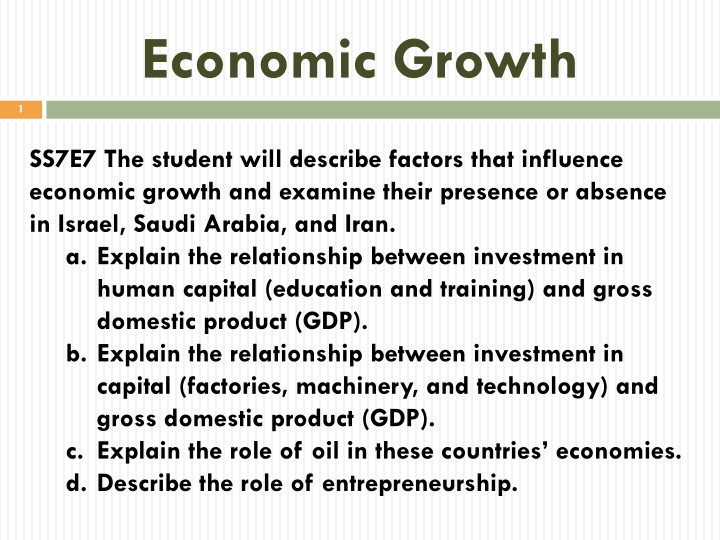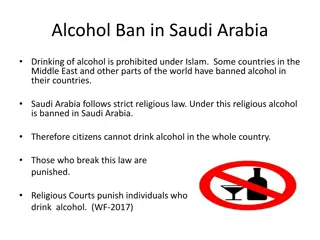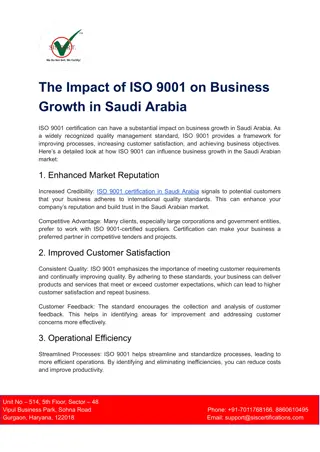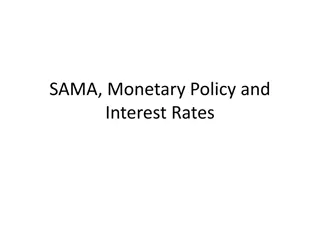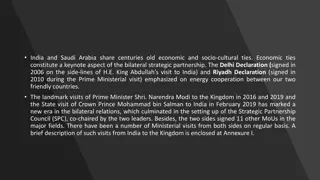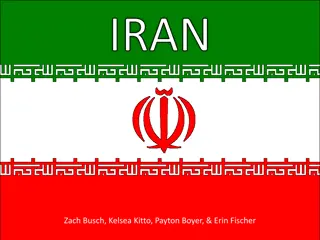Factors Influencing Economic Growth in Israel, Saudi Arabia, and Iran
Explore the relationships between investment in human capital, capital goods, and oil, as well as the role of entrepreneurship, in influencing economic growth in Israel, Saudi Arabia, and Iran. Understand how factors like labor, natural resources, and entrepreneurship contribute to GDP growth. Discover the impact of literacy rates and education on a country's economic development.
Download Presentation

Please find below an Image/Link to download the presentation.
The content on the website is provided AS IS for your information and personal use only. It may not be sold, licensed, or shared on other websites without obtaining consent from the author.If you encounter any issues during the download, it is possible that the publisher has removed the file from their server.
You are allowed to download the files provided on this website for personal or commercial use, subject to the condition that they are used lawfully. All files are the property of their respective owners.
The content on the website is provided AS IS for your information and personal use only. It may not be sold, licensed, or shared on other websites without obtaining consent from the author.
E N D
Presentation Transcript
Economic Growth 1 SS7E7 The student will describe factors that influence economic growth and examine their presence or absence in Israel, Saudi Arabia, and Iran. a. Explain the relationship between investment in human capital (education and training) and gross domestic product (GDP). b. Explain the relationship between investment in capital (factories, machinery, and technology) and gross domestic product (GDP). c. Explain the role of oil in these countries economies. d. Describe the role of entrepreneurship.
Video 2 https://youtu.be/qC-U76O76X0
Factors of Economic Growth 3 Economic growth is the increase in the market value of the goods and services produced by an economy over time. There are many factors that can contribute to the economic growth of an area. The main four factors that influence economic growth are: Labor Capital Goods Land and Natural Resources Entrepreneurship
Labor and Human Capital 4 The workforce of an area or country is usually referred to as labor. An investment in human capital (education and training) can allow the workforce to be better trained and/or more skilled as workers.
Human Capital and GDP 5 Workers that are better trained may have access to more advanced technologies (factories, etc.), safer work environments, and better methods for completing their work, allowing them to produce products or perform services more efficiently. By producing more products and performing more services a country is able to increase their Gross Domestic Product (GDP). Worker have education/training are healthy and have safe working conditions Workers are able to produce a higher quantity and higher quality goods and services More products are made and International trade increases GDP goes up
6 What does GDP stand for? Gross Domestic Product GDP is an estimate of the total market value of all final goods and services produced in the borders of ONE country in ONE year. Translation: estimate of the value of all the stuff a country makes in a year.
Literacy Rate 7 One measure of human capital is the literacy rate of a country s citizens. Literacy rate is the percentage of people who can read and write in a country. This statistic can be used to determine the level of education of people living in a country and is usually tied to the country s GDP. Countries that invest more in the education of their citizens (more schools, training, etc.) normally have higher literacy rates and a higher GDP.
Effect of Literacy on Economics 8 Real Economic Growth is the rate that a country s economy is growing. The growth rate is usually lower for economies that are already really large. Literacy Rate and Economic Growth in Southwest Asia: Israel Literacy Rate: 97.1% Real Economic Growth Rate: 3.1% GDP: $252.8 billion GDP Per Capita: $32,800 Saudi Arabia Literacy Rate: 87.2% Real Economic Growth Rate: 6.8% GDP: $927.1 billion GDP Per Capita: $31,800 Iran Literacy Rate: 85.0% Real Economic Growth Rate: -1.9% GDP: $1.016 trillion GDP Per Capita: $13,300 Israel has had a high literacy rate, and relatively large economy since it s creation. The economy of Saudi Arabia and Iran has grown drastically since the 1980 s. This is partly due to an increase in their literacy rate: Saudi Arabia s literacy rate in 1980 was 48.5%. Iran s literacy rate in 1980 was 50%.
Capital Goods (Resources) 9 Goods such as factories, machines, and tools that workers use to make other goods.
Effect of Capital Goods on Economics 10 Countries can also increase their economy by investing in capital goods. By investing in capital goods (creating new technologies, building new factories, machines, tools, etc.) countries are also able to increase their GDP. For each country below, the investment in capital is shown as a percentage of the country s GDP. Israel Capital Investment: 19.1% Real Economic Growth Rate: 3.1% Saudi Arabia Capital Investment: 26.6% Real Economic Growth Rate: 6.8% Iran Capital Investment: 31.8% Real Economic Growth Rate: -1.9% Israel, Saudi Arabia, and Iran have all made large investments in capital goods. As a result, Israel and Saudi Arabia have shown high economic growth rates. Iran s economy has not grown at the same rate, partly due to the economic sanctions placed on Iran due to their ongoing nuclear energy (weapons) program.
Natural Resources 11 Natural resources are the raw materials used to support life and make goods. Examples: Trees Land Oil
Oil in Southwest Asia (Middle East) 12 Oil is one of the major natural resources found in Southwest Asia. However, not all countries have oil reserves. As a result, access to proven oil reserves can have a major impact on a country s GDP. Impact of oil on GDP: Israel GDP: $252.8 billion Oil: No significant proven oil reserves Saudi Arabia GDP: $927.1 billion Oil: Largest producer and exporter of oil in the world (90% of government revenue comes from oil) Iran GDP: $1.016 trillion Oil: The economy relies primarily on the oil industry. Over 85% of government revenues come from this sector. Over 80% of exports are petroleum and petroleum products. Countries with access to large amounts of oil will usually have a high GDP.
Entrepreneurship 13 Entrepreneurs are people who have an idea for a business, are willing to take a risk, and combine human, natural, and capital resources to produce a new good or service. Entrepreneurs are only able to succeed in a more market system (closer to market than command on the economic continuum), where they have the freedom to control their own economic decisions.
Entrepreneurship in Southwest Asia (Middle East) 14 Countries in Southwest Asia (Middle East) encourage entrepreneurship differently, depending on where they fall on the economic continuum. All information listed below is the Economic Freedom Index (EFI). Israel is moderately open to entrepreneurship. It is relatively easy to start a business, but it takes longer than the world average. Private property rights are well protected by law. Foreign investment is encouraged, but is limited in some sectors.
15 Saudi Arabia is increasingly open to entrepreneurship. The government makes opening, operating, and closing a business easy compared to the world average. There is good protection of private property rights and foreign investment is encouraged, although some investors must have Saudi citizens as partners to operate legally.
16 Iran is not very open to entrepreneurship. The economy of Iran is highly centralized and regulations make it difficult for individuals to open, operate, and close businesses. There is little protection of private property rights, and the government allows very little foreign direct investment.
STOP: Partner Questions 17 Find a partner sitting next to you to answer questions with.
Answer these questions 18 What can we do to increase economic growth in our community? Explain your answer. What can you do now to invest in your own personal human capital? Explain your answer. What happens to GDP when we invest in human capital? Explain your answer. What country has the highest GDP? Israel, Saudi Arabia, or Iran? What country has the biggest capital investment? ? Israel, Saudi Arabia, or Iran? How does oil impact GDP? Explain your answer. Which country would you rather open a business in and why?
